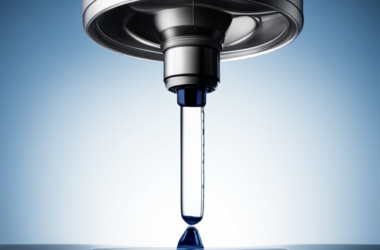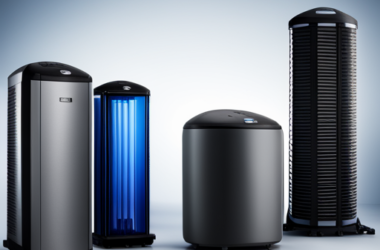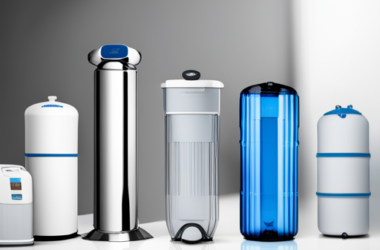Deionized water is a type of purified water that has had all of its ions removed, resulting in a liquid that’s completely free of charge. It is also known as demineralized water or DI water. Normal tap water is full of ions, which come from soil, pipes, and other sources. The only way to remove this charge is by deionizing water.
Deionization is a process that removes all minerals and salts from water, leaving it pure. This process is typically done by using an ion exchange resin that attracts and removes the charged ions in the water. Deionized water is commonly used in laboratories, medical facilities, and industrial settings where high purity water is required.
Deionized water has many unique physical and chemical properties that make it useful in a variety of applications. It is a highly effective solvent, which means that it can dissolve a wide range of substances. It is also non-conductive, making it ideal for use in electronics and other applications where electricity must be controlled. Additionally, deionized water has a neutral pH, which makes it safe for use in many applications.
Key Takeaways
- Deionized water is a type of purified water that has had all of its ions removed.
- Deionization is a process that removes all minerals and salts from water, leaving it pure.
- Deionized water has many unique physical and chemical properties that make it useful in a variety of applications.
Deionization Process
Deionization is a process that removes almost all mineral ions from water, resulting in deionized water (DI water). The process involves the use of ion-exchange resins to remove cations and anions from water. There are several methods of deionization, including ion exchange, co-current deionization, counter-current deionization, mixed bed deionization, and electrodeionization.
Ion Exchange
Ion exchange is the most common method of deionization. It involves the use of ion-exchange resins to remove cations and anions from water. The resins are made of small beads that are coated with charged groups. When water flows through the resin bed, the ions in the water exchange with the ions on the resin beads, resulting in deionized water.
Co-Current Deionization
Co-current deionization involves the flow of water and resin in the same direction. In this method, water enters at the top of the resin bed and flows downward, while the resin is also moving downward. This method is less efficient than counter-current deionization because the resin is less effective at removing ions as it gets closer to the bottom of the bed.
Counter-Current Deionization
Counter-current deionization involves the flow of water and resin in opposite directions. In this method, water enters at the top of the resin bed and flows downward, while the resin is moving upward. This method is more efficient than co-current deionization because the resin is more effective at removing ions as it gets closer to the top of the bed.
Mixed Bed Deionization
Mixed bed deionization involves the use of a mixed ion exchange bed with both positive and negative charged resins. This method is more efficient than single bed deionization because it removes both cations and anions from water.
Electrodeionization
Electrodeionization involves the use of an electric field to remove ions from water. In this method, water flows through a series of ion-exchange membranes and electrodes. The electric field separates the ions from water and collects them on the electrodes, resulting in deionized water.
Overall, deionization is an effective method of removing minerals and ions from water. The method used depends on the specific application and the level of purity required.
Comparison with Other Water Purification Methods
When it comes to water purification, there are several methods available, each with its own advantages and disadvantages. In this section, we will compare deionized water with two other popular water purification methods: Reverse Osmosis and Distillation.
Reverse Osmosis
Reverse Osmosis (RO) is a water purification process that uses a semi-permeable membrane to remove ions, molecules, and larger particles from drinking water. The process works by applying pressure to the water on one side of the membrane, forcing it through the membrane and leaving behind impurities.
Compared to deionization, reverse osmosis is a more effective method of removing impurities from water. RO systems can remove up to 99% of dissolved salts, minerals, and other contaminants from water. However, it is important to note that RO systems are usually more expensive and require more maintenance than deionization systems.
Distillation
Distillation is another popular water purification method that involves boiling water and then capturing the steam as it condenses. The process removes impurities and minerals from the water, leaving behind pure H2O.
Distilled water is similar to deionized water in that it is free from impurities and minerals. However, the distillation process can be time-consuming and expensive, and the resulting water may not be as pure as deionized water.
Overall, while each of these water purification methods has its own advantages and disadvantages, deionized water is a highly effective and efficient way to remove impurities from water. It is also a cost-effective and low-maintenance option for many applications.
Physical and Chemical Properties
pH
Deionized water has a neutral pH of 7. This is because during the deionization process, most of the mineral ions that contribute to the acidity or alkalinity of the water are removed. However, when deionized water comes into contact with carbon dioxide from the air, it can react to produce hydrogen ions, which can make the pH more acidic, driving it closer to 5.6.
Conductivity
Deionized water has a very low electrical conductivity because it has had almost all of its mineral ions removed. The conductivity of deionized water is typically less than 1 microsiemens per centimeter (µS/cm). This makes it useful for applications where low conductivity is important, such as in electronics manufacturing or laboratory experiments.
Resistivity
Deionized water has a high resistivity because it has very few ions that can carry an electric charge. The resistivity of deionized water is typically greater than 1 megaohm-centimeter (MΩ-cm). This makes it useful for applications where high resistivity is important, such as in the production of ultrapure water for semiconductor manufacturing.
In summary, deionized water has a neutral pH of 7, low electrical conductivity, and high resistivity. These properties make it useful for a variety of applications where the presence of mineral ions or other impurities could cause problems.
Impurities in Deionized Water
Deionized water is a type of purified water that has had most of its ions removed through a process called deionization. However, even after deionization, there can be some impurities left in the water. In this section, we will discuss the different types of impurities that can be present in deionized water.
Inorganic Ions
Inorganic ions are one of the most common types of impurities found in deionized water. These ions can include calcium, magnesium, sodium, and chloride, among others. Inorganic ions can be removed from water through a process called ion exchange, which involves exchanging positively charged ions (cations) and negatively charged ions (anions) for hydrogen and hydroxide ions.
Organic Compounds
Organic compounds are another type of impurity that can be present in deionized water. These compounds can include things like pesticides, herbicides, and other chemicals. Organic compounds are typically monitored using Total Organic Carbon (TOC) tests or by specific tests for individual compounds.
Particulates
Particulates are small pieces of matter that can be present in deionized water. These can include things like dirt, sand, and other debris. Particulates can be removed from water through a process called filtration, which involves passing the water through a filter that traps the particulates.
It is important to note that not all impurities in deionized water are harmful. In fact, some impurities may be necessary for certain applications. For example, some non-particulate water impurities like dissolved oxygen and carbon dioxide can be important for biological processes.
In summary, deionized water can still contain impurities even after the deionization process. Inorganic ions, organic compounds, and particulates are among the most common types of impurities found in deionized water. However, not all impurities are harmful, and some may even be necessary for certain applications.
Uses of Deionized Water
Deionized water has a wide range of uses across various industries. Here are some of the most common uses of deionized water:
Industrial Processes
Deionized water is used in various industrial processes, such as electronics manufacturing, metal plating, and chemical production. It is preferred over tap water because it does not contain any minerals or impurities that can interfere with the manufacturing process. Deionized water is also used in steam irons and humidifiers to prevent mineral buildup.
Pharmaceutical Industries
Pharmaceutical companies use deionized water to manufacture drugs and medical products. Deionized water is preferred over tap water because it is free of contaminants that can affect the purity and effectiveness of the drugs. It is also used to clean equipment and prepare solutions.
Laboratories
Deionized water is commonly used in laboratories for experiments and analysis. It is preferred over tap water because it is free of minerals and impurities that can affect the accuracy of the results. Deionized water is used to prepare solutions, rinse glassware, and clean equipment.
Cooling Systems
Deionized water is used in cooling systems to prevent mineral buildup and corrosion. It is preferred over tap water because it does not contain minerals that can clog pipes and reduce the efficiency of the cooling system. Deionized water is also used in car batteries to prevent mineral buildup.
Aquariums
Deionized water is used in aquariums to provide a clean and healthy environment for fish and other aquatic animals. It is preferred over tap water because it is free of contaminants that can harm the fish. Deionized water is also used in fish tanks to prevent mineral buildup and algae growth.
Cosmetics
Deionized water is used in the manufacturing of cosmetics and personal care products. It is preferred over tap water because it is free of minerals and impurities that can affect the quality and stability of the products. Deionized water is used to prepare solutions, dissolve ingredients, and clean equipment.
Food Processing
Deionized water is used in the food processing industry for various purposes, such as cleaning equipment, preparing solutions, and rinsing fruits and vegetables. It is preferred over tap water because it is free of contaminants that can affect the quality and safety of the food. Deionized water is also used in beverage production to ensure the purity and consistency of the products.
In conclusion, deionized water has a wide range of uses across various industries. Its purity and lack of impurities make it a preferred choice over tap water in many applications.
Safety and Consumption of Deionized Water
Deionized water is a type of purified water that has had all of its mineral ions removed through a process of ion exchange. This process makes the water highly pure and free from impurities such as minerals, salts, and other contaminants. However, it is important to note that deionized water is not considered a safe drinking water source due to its lack of minerals and nutrients that are essential for human health.
Consuming deionized water on a regular basis can have some harmful health effects. While the process of removing mineral ions from water doesn’t necessarily make it unsafe to drink, it’s important to keep in mind that deionization only removes the ions. Other contaminants such as bacteria and viruses are not removed in this process. Therefore, it is not recommended to consume deionized water in large quantities or as a primary source of drinking water.
Deionized water is primarily used for industrial and laboratory purposes, such as in the production of pharmaceuticals, electronic components, and laboratory experiments. It is also used in some medical procedures and can be used in certain types of batteries and other industrial applications.
In terms of safety, deionized water is generally considered safe for use in industrial and laboratory settings. However, it is important to handle deionized water with care, as it can still pose a risk if it comes into contact with certain chemicals or substances.
Overall, deionized water is a highly purified form of water that is safe for use in certain settings. However, it is not recommended for consumption as a primary source of drinking water due to its lack of essential minerals and nutrients and the potential risk of exposure to harmful bacteria and viruses.
Regeneration of Deionized Water
To maintain the effectiveness of a deionized water system, the resin bed must be regenerated periodically. Regeneration is the process of removing the accumulated ions from the resin bed and flushing them from the system. This allows the ion exchange resins to continue deionization effectively.
There are different methods for regenerating a deionized water system, but the most common one is the use of caustic acid. During the regeneration process, the resin bed is flushed with a solution of caustic acid to remove the collected ions. The caustic acid solution breaks the bond between the ions and the resin, freeing the ions from the resin bed.
After the resin bed has been regenerated, it must be rinsed thoroughly to remove any remaining traces of the caustic acid solution. The rinsing process is crucial because any residual acid can damage the resin bed and reduce its effectiveness.
The frequency of regeneration depends on the quality of the feed water, the volume of water processed, and the type of resin used. Over time, the resin bed will become saturated with ions, reducing its effectiveness. When the system’s output water quality drops below the desired level, it is an indication that the resin bed needs to be regenerated.
In summary, regeneration is a critical process in maintaining the effectiveness of a deionized water system. It involves removing the accumulated ions from the resin bed and flushing them from the system. The frequency of regeneration depends on various factors, including the quality of the feed water and the type of resin used.
Challenges and Limitations
While deionized water has numerous benefits, there are also some challenges and limitations associated with its use.
Costly
One of the biggest challenges of using deionized water is its cost. The process of producing deionized water can be expensive, depending on the size of the system and the volume of water needed. Additionally, the cost of replacing the resin beads used in the ion-exchange process can add up over time.
Scale
Another challenge associated with deionized water is scale. Since deionized water is free of minerals, it can be more aggressive in dissolving minerals and metals from pipes and equipment. This can lead to scale buildup, which can cause damage to the equipment and reduce its lifespan.
Resin Beads
The ion-exchange process used to produce deionized water requires resin beads to remove the ions from the water. These beads can become saturated over time, reducing their effectiveness and requiring replacement. The process of replacing the resin beads can be time-consuming and costly, further adding to the expense of using deionized water.
Overall, while deionized water has many benefits, it is important to consider the challenges and limitations associated with its use. These factors, including cost, scale buildup, and resin bead replacement, should be carefully evaluated when deciding whether to use deionized water in a particular application.
Frequently Asked Questions
What are the benefits of using deionized water?
Deionized water is free of cations and anions, which makes it ideal for use in various industries where pure water is required. It is also used in laboratories for experiments that require precise measurements. Deionized water is also used in car batteries, as it helps prevent the buildup of mineral deposits that can reduce the battery’s lifespan.
How is deionized water different from tap water?
Tap water contains various minerals and chemicals that can affect its pH level and taste. Deionized water, on the other hand, is free of these minerals and chemicals, making it ideal for use in various applications.
What industries commonly use deionized water?
Deionized water is commonly used in industries such as pharmaceuticals, cosmetics, electronics, and food and beverage. It is also used in laboratories for experiments that require precise measurements.
How is deionized water produced?
Deionized water is produced through a process called ion exchange, which involves removing the mineral ions from the water. This is done using ion exchange resins, which attract and remove the mineral ions from the water.
What are the advantages of using deionized water in car batteries?
Deionized water is used in car batteries as it helps prevent the buildup of mineral deposits that can reduce the battery’s lifespan. It also helps improve the battery’s performance by allowing for better conductivity and reducing the risk of corrosion.
Can deionized water be used for medical purposes?
Deionized water is not typically used for medical purposes as it lacks the minerals and nutrients that are present in regular drinking water. However, it is used in some medical applications where pure water is required, such as in dialysis machines.



